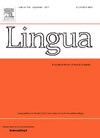Evidence for syntactic audience design from the production of active and passive relative clauses in Chinese
IF 1.3
3区 文学
0 LANGUAGE & LINGUISTICS
引用次数: 0
Abstract
This study examines audience design at the syntactic level. We report two language production experiments investigating how Mandarin Chinese speakers choose between object relative clauses (ORCs) and passive subject relative clauses (pSRCs) to refer to patients in target events. These structures differ in syntactic function assignments. The production experiments vary in whether or not speakers interact with a real listener (Experiment 1 and 2). Two factors were manipulated: (1) the number of events in the visual stimuli eliciting verbal responses, and (2) the animacy configuration of referents. Results show that speakers adjust their syntactic choices to facilitate comprehension, with effects varying by the presence of a listener. Syntactic adaptations also increase production difficulty to some extent. A third experiment complements the findings with a language comprehension study using the visual world paradigm. The target responses from Experiments 1 and 2 served as the linguistic structures from which auditory stimuli were produced. Results reveal that the structure speakers avoided to produce under certain conditions (pSRCs with two depicted events) hindered comprehension, whereas the same structure improved comprehension in simpler contexts (pSRCs with one event). We discuss the findings with reference to different language production models.
从汉语主动和被动关系从句的产生看句法受众设计的证据
本研究从句法层面考察受众设计。我们报告了两个语言生成实验,研究了汉语普通话使用者如何在目标事件中选择宾语关系从句和被动主语关系从句来指代患者。这些结构在语法功能分配上有所不同。生产实验的不同之处在于演讲者是否与真正的听众互动(实验1和2)。两个因素被操纵:(1)视觉刺激中引起言语反应的事件数量;(2)指涉物的动性配置。结果表明,说话者会调整他们的句法选择以促进理解,其效果因听众的存在而异。句法调整也在一定程度上增加了制作难度。第三个实验与使用视觉世界范式的语言理解研究相辅相成。实验1和实验2的目标反应是产生听觉刺激的语言结构。结果表明,说话者在特定条件下(包含两个描述事件的psrc)避免产生的结构阻碍了理解,而在更简单的语境下(包含一个事件的psrc)相同的结构促进了理解。我们将参考不同的语言生产模型来讨论这些发现。
本文章由计算机程序翻译,如有差异,请以英文原文为准。
求助全文
约1分钟内获得全文
求助全文
来源期刊

Lingua
Multiple-
CiteScore
2.50
自引率
9.10%
发文量
93
审稿时长
24 weeks
期刊介绍:
Lingua publishes papers of any length, if justified, as well as review articles surveying developments in the various fields of linguistics, and occasional discussions. A considerable number of pages in each issue are devoted to critical book reviews. Lingua also publishes Lingua Franca articles consisting of provocative exchanges expressing strong opinions on central topics in linguistics; The Decade In articles which are educational articles offering the nonspecialist linguist an overview of a given area of study; and Taking up the Gauntlet special issues composed of a set number of papers examining one set of data and exploring whose theory offers the most insight with a minimal set of assumptions and a maximum of arguments.
 求助内容:
求助内容: 应助结果提醒方式:
应助结果提醒方式:


